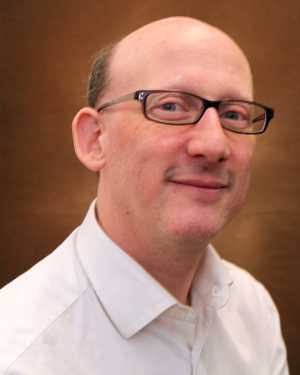Jean-Marc Dreyfus Lecture Summary: Corpses of the Holocaust

By Badema Pitic, VHA Program Coordinator, Center for Advanced Genocide Research
Jean-Marc Dreyfus, the 2018-2019 Center Research Fellow, gave a public lecture last month about his semester-long research at the USC Shoah Foundation Center for Advanced Genocide Research. Professor Dreyfus’ lecture, entitled “Corpses of the Holocaust,” focused on the discussions of corpses in the Visual History Archive (VHA) testimonies of Holocaust survivors and liberators.
To provide some context for his research at the Center, Professor Dreyfus began the Nov. 13 lecture by arguing that while much scholarship about mass violence and genocide has focused on trauma and memory as being products of genocide, there is another direct product of genocide that has not received as much scholarly attention: the bodies of those who were killed. From 2012 to 2016, Professor Dreyfus and anthropologist Elisabeth Anstett directed a large research project entitled “Corpses of Mass Violence and Genocide.” This qualitative, comparative, and multidisciplinary project focused on three main topics relating to corpses: destruction; search and identification; and (re)conciliation/human remains in the society. The “destruction” segment of the project dealt with the treatment of corpses during and after mass violence and genocide, particularly with the questions of how, when, and by whom are the bodies destroyed. In the “search and identification” part of the project, Professors Dreyfus and Anstett were interested in the practices and procedures surrounding the post-violence search for and identification of corpses. Lastly, the “(re)conciliation/human remains in the society” segment of the project concerned the role and significance of corpses in a society, especially when it comes to memory, politics of commemoration, and reconciliation.
Professor Dreyfus was curious to see what the testimonies housed in the Visual History Archive would reveal about the treatment of corpses in the Holocaust. He pointed out the difficulty of locating material related to his topic in the archive, as interviewees were not specifically asked about corpses or exhumations during their interviews. Despite the initial difficulty in finding material, he expressed surprise about all he discovered in the VHA. During his residency at the Center, he studied 63 testimonies in depth. Of these 63, 10 interviewees discussed exhumations during the Holocaust, 38 interviewees discussed them in the context of the aftermath of the Holocaust, and 15 remaining testimonies were by liberators. Professor Dreyfus chose to work with liberators’ testimonies because liberators encountered corpses at the concentration camps they liberated, and they witnessed the ensuing treatment of corpses, such as in cases when survivors themselves had to deal with dead bodies. To illustrate, he showed the photos of the liberation of Nordhausen that featured corpses, and also referred to the testimonies of John Zingheim and Robert Powers from the VHA.
Next, Professor Dreyfus (University of Manchester, United Kingdom) discussed exhumations of corpses during and after the Holocaust. When it comes to exhumations that happened during the Holocaust, he pointed out that the materiality of the corpses – smell and touch, in particular – was vividly recounted in the testimonies and the affective associations related to corpses emerged in the testimonies as well. He discussed both individual and collective exhumations that took place during these periods. As an example of an individual exhumation, Professor Dreyfus referred to the discussion of one such exhumation and reburial in Hungary in the testimony by David Wachsberg. Similarly, he mentioned several cases of collective exhumations mentioned in the testimonies, such as the one described by Helena Manaster that took place in the Lodz ghetto. Finally, Professor Dreyfus noted the significance of religious rituals that accompanied post-Holocaust reburials, and the important role of rabbis who often organized them.
In concluding his lecture, Professor Dreyfus returned to the topic of corpses and exhumations in the Visual History Archive, particularly the scope of its presence. He left open the question about the reasons for the lack of discussion of this topic, pointing to several possibilities, including the lack of collective memory framework for such stories to be told.
Professor Dreyfus’ lecture was followed by a Q&A session, which included discussion of the manner in which human remains are memorialized; different cultural perspectives on human remains; distinctions in narratives about corpses between liberators, those performing exhumations, and survivors; gendered destruction of corpses and gendered differences in narratives about exhumations; mentions of corpses in survivor memoirs; the influence of Jewish funerary traditions on the treatment of corpses; the role of movement in the visual culture of exhumation; the types of narratives that accompany the photos of exhumations that survivors show during their interviews in the VHA; and Professor Dreyfus’ expectations about the VHA and his experience working with testimonies.
Like this article? Get our e-newsletter.
Be the first to learn about new articles and personal stories like the one you've just read.